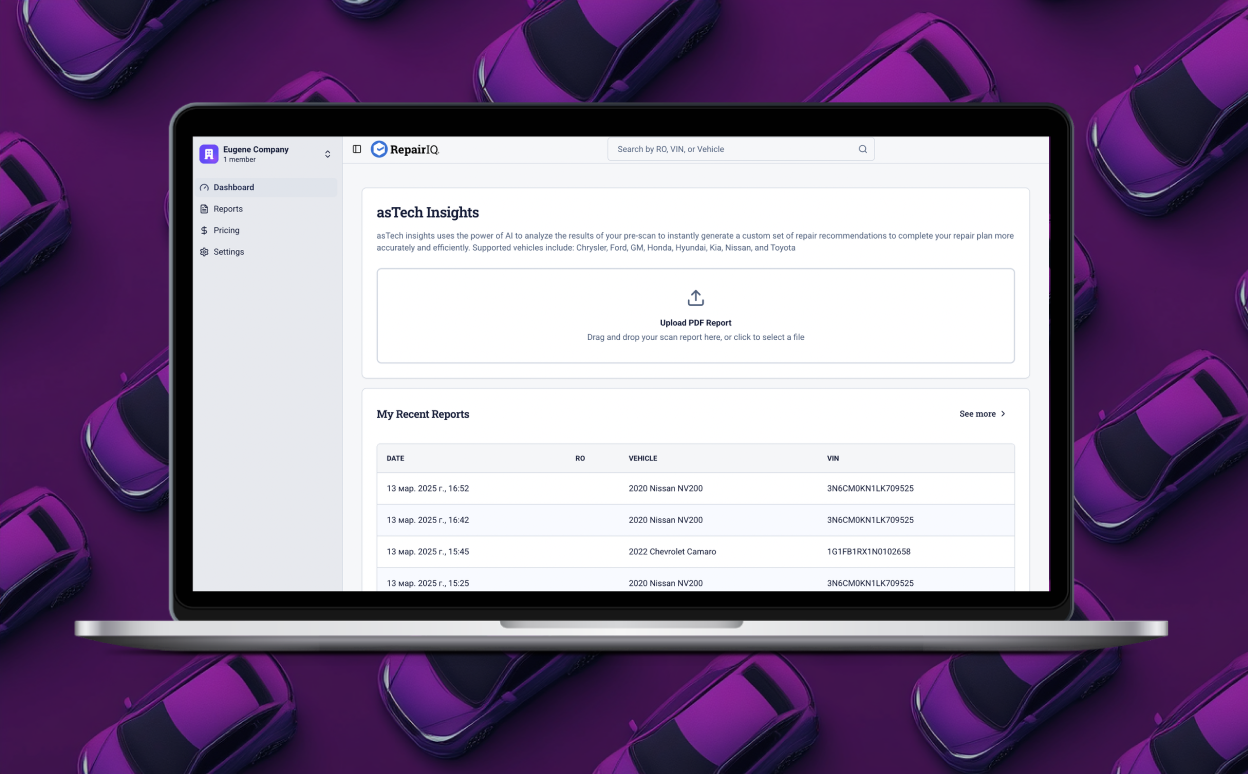Astech (naming is nominal) is a technology company specializing in the development of innovative solutions for the automotive industry. The company focuses on creating digital products that optimize the processes of diagnostics, repair, and management of vehicles, connecting car service centers, car owners, and spare parts suppliers into a single ecosystem.
Initially, the task was to develop an advanced tool for digital vehicle diagnostics. During the process, the project evolved into the creation of a comprehensive multi-module platform that was supposed to:
Decode VIN numbers to obtain complete information about the vehicle and its history.
Automate the analysis of diagnostic reports from car service centers using AI.
Generate detailed reports for customers with repair recommendations, a list of necessary spare parts, and the nearest partner service stations.
Implement a license plate recognition (LPR) system for various purposes, including security (searching for stolen vehicles).
Combine all services under a single interface for administrators, users, and partners.
Ensure scalability, security, and integration with external systems (police databases, insurance companies, suppliers).
We designed and currently are developing a cloud platform for car service centers based on microservice architecture, which includes several main modules:
VIN Decoder Service: A microservice for decoding VINs, providing data on vehicles, manufacturers, repair history, and owners.
Diagnostic & Reporting Service: This is the core of the automotive diagnostics program. It uses a VIN decoder, sensor data, and an AI module to analyze faults. It generates a detailed report with recommendations for repairs, spare parts selection, and a list of suitable service stations. It is integrated with PDF report generation services, a repair knowledge base, and insurance company data.
License Plate Recognition (LPR) Service: A microservice for scanning license plates using stationary/mobile cameras and partner tablets. It receives information about vehicles and owners and is integrated with police hot lists for instant alerts about stolen cars.
Admin Dashboard: Centralized control panel for system administrators (user management, master data management, module monitoring).
User/Partner Portal: Web interface for end users (vehicle owners) and partner companies (service stations) for generating reports, searching for spare parts, and diagnostics.
Mobile LPR App: A mobile application for scanning license plates by employees of partner organizations or mobile patrols.
The platform is being developed in collaboration with an international team (USA, Mexico, Russia). The project is in active development and iterative improvement.

Analysis and design
Defining requirements, selecting microservice architecture, designing module interactions.
Development of MVP modules
Implementation of basic functionality for key services (VIN, Reporting Core, LPR).
Integration and expansion
Integrating microservices, adding new functionality (AI analysis, integration with partners, LPR Hot List).
Testing (Ongoing)
Development and scaling
Constantly adding new features, optimizing existing ones, expanding the partner network and user base.
The platform offers the following features:


It was necessary to ensure the coordinated and reliable operation of multiple microservices, as well as their integration with various external systems, including diagnostic equipment from different manufacturers, police databases, and partner APIs. Our task was to develop and train AI models for accurate fault analysis.
It was also necessary to provide high performance and scalability of the cloud infrastructure (AWS) for processing large volumes of data, including streams from LPR cameras.
The priority was to create a secure authentication and authorization system for various user roles (Clerk) and to develop an intuitive user interface for complex diagnostic and reporting processes.
The platform is currently under active development, with key modules already beyond the MVP stage and undergoing testing. The system demonstrates the potential for significant transformation of processes in the auto service industry. It automates processes, improves diagnostic accuracy, creates a unified ecosystem, and introduces innovative security features, forming the basis for a scalable subscription-based business.